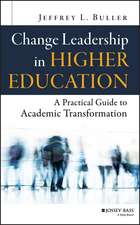Academic Units in a Complex, Changing World: Adaptation and Resistance
Autor Deanna de Zilwaen Limba Engleză Paperback – 6 noi 2014
| Toate formatele și edițiile | Preț | Express |
|---|---|---|
| Paperback (1) | 637.13 lei 43-57 zile | |
| SPRINGER NETHERLANDS – 6 noi 2014 | 637.13 lei 43-57 zile | |
| Hardback (1) | 643.34 lei 43-57 zile | |
| SPRINGER NETHERLANDS – 29 sep 2010 | 643.34 lei 43-57 zile |
Preț: 637.13 lei
Preț vechi: 749.56 lei
-15% Nou
Puncte Express: 956
Preț estimativ în valută:
121.93€ • 126.83$ • 100.66£
121.93€ • 126.83$ • 100.66£
Carte tipărită la comandă
Livrare economică 14-28 aprilie
Preluare comenzi: 021 569.72.76
Specificații
ISBN-13: 9789400797772
ISBN-10: 940079777X
Pagini: 228
Ilustrații: XXV, 199 p.
Dimensiuni: 155 x 235 x 12 mm
Greutate: 0.33 kg
Ediția:2010
Editura: SPRINGER NETHERLANDS
Colecția Springer
Locul publicării:Dordrecht, Netherlands
ISBN-10: 940079777X
Pagini: 228
Ilustrații: XXV, 199 p.
Dimensiuni: 155 x 235 x 12 mm
Greutate: 0.33 kg
Ediția:2010
Editura: SPRINGER NETHERLANDS
Colecția Springer
Locul publicării:Dordrecht, Netherlands
Public țintă
ResearchCuprins
The Framework.- Complex, Turbulent Exogenous Environments.- Research Design and Methods.- to the Empirical Findings.- The Case Studies.- Defenders.- Prospectors.- Analysers.- Reactors/Resistants.- Conceptual and Practical Reflections.- Discussion and Conclusions.- Exploring Conceptual and Practical Implications of This Work.- Current and Emerging Challenges.
Textul de pe ultima copertă
This book uses case studies of academic units from Australian public universities to explore the reasons why those units respond in different ways to similar contemporary challenges. The ‘academic units’—departments, schools and faculties—in the world’s public universities may be their own administrative fiefdoms, but the wider environment within which they operate is both complex and dynamic. In fact, today’s academic landscape is barely recognizable from what it was like two decades ago. The globalization of higher education markets for students, faculty and research funding has expanded the challenges and opportunities for academic units beyond the boundaries of nation states. However, academic units must also deal with the diverse needs and expectations of national and local stakeholders, as well as operate within government regulatory and policy frameworks. In addition, they are required to adhere to policy and operational directives from institutional executives and consider the often-competing needs and expectations of other stakeholders such as faculty, students, employers, funding bodies and professional associations. As public funding slowly evaporates some university faculties have embraced the imperative to be more business-oriented. Others have shrunk from congress with Mammon.The milieu of tertiary education is having to adapt to fresh trends in this domain, such as the advocacy of marketization, entrepreneurialism and corporatization, the three pillars of so-called ‘new public management’. With its case studies from different academic disciplines and types of university, this book asks some key questions: Why do some units adapt to environmental challenges and others resist change? How and why do academic units adopt different modes and processes of adaptation or resistance? Along with its new conceptual framework for the wider context, the text makes an important contribution to scholarship on leading and managing change inuniversities, while at the same time offering those in academic leadership positions relevant advice and practical suggestions to guide their units through these complex challenges. Where other academic studies have examined the university as an institution in its entirety, this focused study compares the decision-making on a lower rung of the administrative ladder.
Caracteristici
It explores the fabric of academic units efforts to deal with change with close attention to detail Develops new conceptual frameworks on academic units adaptation and resistance to changing environments Offers university executives, heads of academic units and faculty practical suggestions for dealing with environmental challenges









